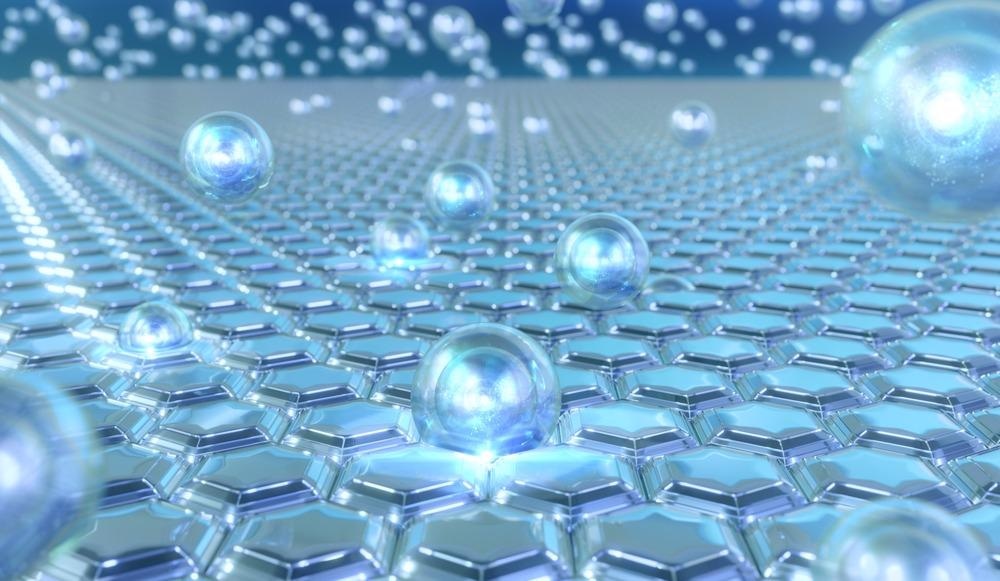A paper available in the journal Carbon as a pre-proof describes the production of self-arranged Q-carbon and Q-BN nanoballs achieved with the nanosecond laser melting of carbon and BN films.

Study: Self-organization of amorphous Q-carbon and Q-BN nanoballs. Image Credit: J9P/Shutterstock.com
Synthesis Methods for c-BN and Diamond
As c-BN and diamond are metastable at typical pressures and temperatures, their fabrication and processing need abnormally elevated pressures and temperatures.
To avoid oxidation of carbon, fabrication and processing at severe pressures and temperatures necessitate highly neutral environments, leading to relatively small outputs in the shape of granules, which are unsuitable for thin coating applications.
To make diamond, which is a metastable stage of carbon, CVD (chemical vapor deposition) is an equilibrium approach that must be supplemented with non-equilibrium techniques such as microwaves and hot-filament.
This mixture of equilibrium and non-equilibrium synthesizing yields a non-equilibrium and metastable state of diamond blended with an equilibrium state of graphite; the graphite state is selectively erased by atomic hydrogen to generate diamond as a residual phase.
In HFCVD, hot filaments form atomic hydrogen, whereas microwaves generate atomic hydrogen in MPCVD.
Limitations of the CVD Approach
As a result, owing to an absence of selective etching of h-BN, these CVD procedures provide considerable hurdles for the generation of epitaxial and phase-pure diamond growths and even greater issues for synthesizing phase-pure c-BN.
Furthermore, due to the large nucleation threshold for diamond, particularly on non-carbide producing materials, these approaches need the usage of diamond seeds for development.
The fabrication and processing of diamond and c-BN restrict the integration of dopants into electroactive substitutional sites near the thermodynamic equilibrium solubility threshold, which is often fairly low.
The high energy states of dopants result in extremely low amounts of free carriers. Moreover, these CVD processes only permit for p-type doping of diamond, making the development of p-n junctions and associated solid-state devices almost unachievable.
Nanosecond Laser Processing
The use of nanosecond lasers to treat BN and carbon layers, nanotubes, and nanorods has unveiled new possibilities for the fabrication and processing of phase-pure diamond and c-BN at regular pressures and temperatures.
Undercooled carbon and BN layers are quickly chilled in this technique to generate phase-pure diamond and c-BN via a first-order phase change at regular temperature and pressure.
Diamond and c-BN sheets may be produced as epitaxial films by domain fitting epitaxy on precursors with substantial lattice and heat mismatches by supplying an adequate precursor blueprint.
Owing to kinetically induced solute entrapment, these sheets may be treated with p-type and n-type dopants at quantities much above the thermodynamic dissolution limitations.
The optimum laser treatment settings are driven by extensive laser-sold reactions simulations that incorporate thin sheet, laser, and precursor factors. Optical absorption spectra (bandgap), sp3 to sp2 proportion, heat conduction and specific heat of the sheet; heat conduction and specific heat of the platform; and wavelength of the laser (photon energy), pulse frequency, and power density of the laser pulse are the critical factors.
By enhancing the undercooling, different allotropes of carbon (Q-carbon) and BN allotropes (Q-BN) can be created.
Previous research has shown that Q-carbon has exceptional features such as RT ferromagnetization, extraordinary hardness, unprecedented BCS super-conductance, increased field emissions, and radiation tolerance. Some of these features are predicted to be increased further in Q-BN and Q-carbon nanoballs.
Thin Q-carbon sheets have also been reported to be about 70% stronger than diamond; consequently, nanoballs could be even tougher than Q-carbon thin sheets.
Important Findings of the Study
The team synthesized nanoballs of Q-carbon in this work by melting carbon sheets in a very undercooled condition and then cooling rapidly at atmospheric pressure in air. Likewise, QBN nanoballs were created by melting BN in a significantly undercooled condition and then cooling rapidly at atmospheric temperature in air.
Specific orientations of diamond tetrahedra allow the nanoballs to self-arrange into strings and rings. By adjusting the laser, carbon sheet, and precursor settings, the dimensions of these Q-carbon and Q-BN nanoballs may be altered between 5-100 nm.
When Q-carbon films are treated with boron, they exhibit strong ferromagnetization and BCS elevated temperature superconduction.
The team anticipates that B-doped Q-carbon nanoballs will have a greater superconduction transition temperature due to enhanced phonon-electron interaction.
Super-hard nanoballs are likely to find innovative uses varying from targeted drug administration and medicinal uses to nanosensors and extremely effective field-emission screens.
Reference
Narayan, J., & Khosla, N. (2022). Self-organization of amorphous Q-carbon and Q-BN nanoballs. Carbon. Available at: https://doi.org/10.1016/j.carbon.2022.03.003
Disclaimer: The views expressed here are those of the author expressed in their private capacity and do not necessarily represent the views of AZoM.com Limited T/A AZoNetwork the owner and operator of this website. This disclaimer forms part of the Terms and conditions of use of this website.